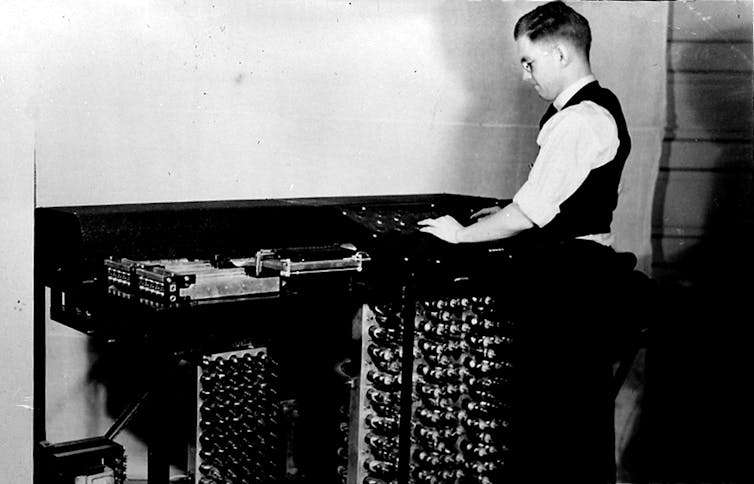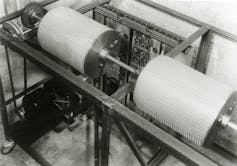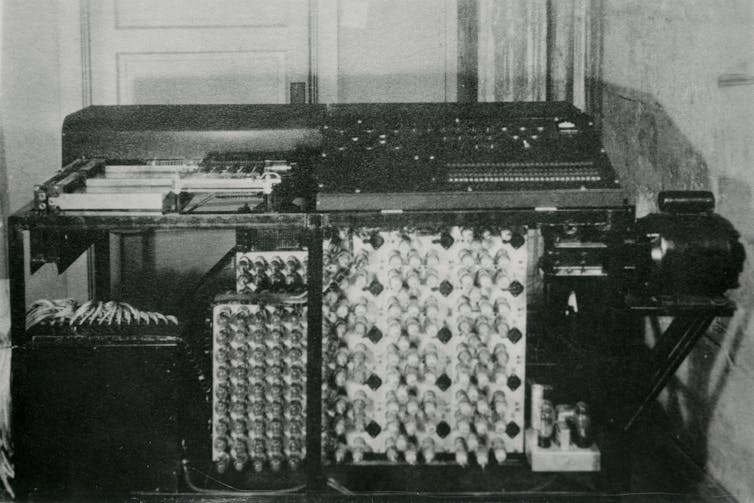
Doug Jacobson, Iowa State University

Curious Kids is a series for children of all ages. If you have a question you’d like an expert to answer, send it to This email address is being protected from spambots. You need JavaScript enabled to view it..
What was the first computer? – Emily, age 9, Newton, Massachusetts
The first modern electronic digital computer was called the Atanasoff–Berry computer, or ABC.
It was built by physics Professor John Vincent Atanasoff and his graduate student, Clifford Berry, in 1942 at Iowa State College, now known as Iowa State University.
That’s where I have been teaching computer engineering for over 30 years, and I’m also a collector of old computers. I got to meet Atanasoff when he visited Iowa State and got a signed copy of his book.
Before ABC, there were mechanical computing devices that could perform simple calculations. The first mechanical computer, The Babbage Difference Engine, was designed by Charles Babbage in 1822. The ABC was the basis for the modern computer we all use today.

The ABC weighed over 700 pounds and used vacuum tubes. It had a rotating drum, a little bigger than a paint can, that had small capacitors on it. A capacitor is device that can store an electric charge, like a battery.
The ABC was designed to solve problems with up to 29 different variables. You might be familiar with equations with one variable, like 2y = 14. Now imagine 29 different variables. These are common problems in physics and other sciences, but were difficult and time-consuming to solve by hand.
Atanasoff was credited with several breakthrough ideas that are still present in modern computers. The most important idea was using binary digits, just ones and zeroes, to represent all numbers and data. This allowed the calculations to be performed using electronics.
Another idea was the separation of the program (the computer instructions) and memory (places to store numbers).
The ABC completed one operation about every 15 seconds. Compared to the millions of operations per second of today’s computer, that probably seems very slow.
Unlike today’s computers, the ABC did not have a changeable stored program. This meant the program was fixed and designed to do a single task. This also meant that, to solve these problems, an operator had to write down the intermediate answer and then feed that back into the ABC. Atanasoff left Iowa State before he perfected a storage method that would have eliminated the need for the operator to reenter the intermediate results.

Shortly after Atanasoff left Iowa State, the ABC was dismantled. Atanasoff never filed a patent for his invention. That means that, for a long time, many people weren’t aware of the ABC.
In 1947, the creators of the Electronic Numerical Integrator And Computer, or ENIAC, filed a patent. This allowed them to claim they were the inventors of the digital computer. For several decades, most people thought that the ENIAC was the first modern computer.
But one of the inventors of the ENIAC had visited Atanasoff in 1941. The courts later ruled that this visit influenced the design of the ENIAC. The ENIAC patent was thrown out by a judge in 1973.
The holders of the ENIAC patent argued that the ABC never really worked. Since all that remained was one of the drum memory units, it was hard to prove otherwise.
In 1997 a team of faculty, researchers and students at Iowa State University finished building a replica of the ABC. They were able to demonstrate that the ABC did function. You can see the replica today at the Computer History Museum in Mountain View, California.
Hello, curious kids! Do you have a question you’d like an expert to answer? Ask an adult to send your question to This email address is being protected from spambots. You need JavaScript enabled to view it.. Please tell us your name, age and the city where you live. We won’t be able to answer every question, but we will do our best.
[ Like what you’ve read? Want more? Sign up for The Conversation’s daily newsletter. ]![]()
Doug Jacobson, Professor of Electrical and Computer Engineering, Iowa State University
This article is republished from The Conversation under a Creative Commons license. Read the original article.

